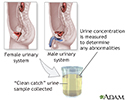Urine concentration test
Water loading test; Water deprivation test
A urine concentration test measures the ability of the kidneys to conserve or excrete water.
How the Test is Performed
For this test, some or all of the specific gravity of urine, urine electrolytes, and urine osmolality are measured before and after one or more of the following:
- Water loading. Drinking large amounts of water or receiving fluids through a vein.
- Water deprivation. Not drinking fluids for a certain amount of time.
- Antidiuretic hormone (ADH) administration. Receiving ADH, which should cause the urine to become concentrated.
After you provide a urine sample, it is tested right away. For urine specific gravity, your health care provider uses a dipstick made with a color-sensitive pad. The dipstick color changes and tells the provider the specific gravity of your urine. The dipstick test gives only a rough result. For a more accurate specific gravity result or measurement of urine electrolytes or osmolality, your provider will send your urine sample to a lab.
If needed, your provider will ask you to collect your urine at home over 24 hours. Your provider will tell you how to do this. Follow instructions exactly.
How to Prepare for the Test
Eat your normal diet for several days before the test. Your provider will give you instructions for water loading or water deprivation.
Your provider will ask you to temporarily stop any medicines that may affect the test results. Be sure to tell your provider about all the medicines you take, including dextran and sucrose. Do not stop taking any medicine before talking to your provider.
Also tell your provider if you recently received intravenous dye (contrast medium) for an imaging test such as a CT scan or MRI scan. The dye can also affect test results.
How the Test will Feel
The test involves only normal urination. There is no discomfort.
Why the Test is Performed
This test is most often done if your provider suspects central diabetes insipidus, a condition where there is an abnormality with ADH that regulates the concentration of the urine. The test can help tell that disease from nephrogenic diabetes insipidus, a condition where there is an abnormality in the kidney that prevents ADH from correctly regulating the concentration of the urine.
This test may also be done if you have signs of syndrome of inappropriate ADH (SIADH).
Normal Results
In general, normal values for specific gravity are as follows:
- 1.005 to 1.030 (normal specific gravity)
- 1.001 after drinking excessive amounts of water
- More than 1.030 after avoiding fluids
- 50 percent rise in specific gravity after receiving ADH
Normal value ranges may vary slightly among different laboratories. Some labs use different measurements or test different samples. Talk to your provider about the meaning of your specific test results.
What Abnormal Results Mean
Increased urine concentration may be due to conditions, such as:
- Glucose (a type of sugar) in the urine
- Heart failure
- Loss of body fluids (dehydration) from diarrhea, vomiting, or excessive sweating
- Narrowing of the kidney artery (renal arterial stenosis)
- SIADH
Decreased urine concentration may indicate:
- Diabetes insipidus
- Drinking too much fluid
- Kidney failure (loss of ability to reabsorb water)
- Severe kidney infection (pyelonephritis)
Risks
There are no risks with this test.
References
Navarro D, Fonseca NM, Garigali G, Fogazzi GB. Urinalysis. In: Johnson RJ, Floege J, Tonelli M, eds. Comprehensive Clinical Nephrology. 7th ed. Philadelphia, PA: Elsevier; 2024:chap 4.
Riley RS, McPherson RA. Basic examination of urine. In: McPherson RA, Pincus MR, eds. Henry's Clinical Diagnosis and Management by Laboratory Methods. 24th ed. Philadelphia, PA: Elsevier; 2022:chap 29.
Verbalis JG. Posterior pituitary. In: Goldman L, Cooney KA, eds. Goldman-Cecil Medicine. 27th ed. Philadelphia, PA: Elsevier; 2024:chap 206.
Urine concentration test - illustration
Urine concentration test
illustration
Female urinary tract - illustration
Female urinary tract
illustration
Male urinary tract - illustration
Male urinary tract
illustration
Review Date: 8/20/2023
Reviewed By: Jacob Berman, MD, MPH, Clinical Assistant Professor of Medicine, Division of General Internal Medicine, University of Washington School of Medicine, Seattle, WA. Also reviewed by David C. Dugdale, MD, Medical Director, Brenda Conaway, Editorial Director, and the A.D.A.M. Editorial team.













